 Indians Archive
Indians Archive  Tribe Game Vault: 4/23/1948. American Hero, Larry Doby - The Talent Begins to Shine
Tribe Game Vault: 4/23/1948. American Hero, Larry Doby - The Talent Begins to Shine
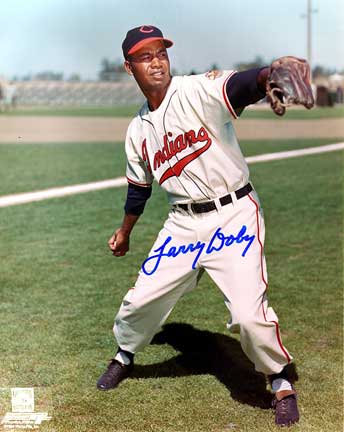 I need to unwind.
I need to unwind.
And maybe only peek at the Tribe game now and then, tonight. Enough said there.
I feel lazy, but with a couple hours left until twilight on this gorgeous day, I think I’ll get out and run over to the park. T-shirt and running shorts? Check and check. Glasses strap and shoes? Check and check. iPod dialed up to Gov’t Mule’s By a Thread? Oh, yeah. (Thanks to Lars Hancock of this site for the tip on that). My stretching ritual behind me, I lean into a brisk walk down the driveway and onto the sidewalk. I am trotting to the pounding rhythms in my ears before my legs can procrastinate any further.
Me: So, you’re going to write an article on Larry Doby, huh?
Myself: Yeah… Why wouldn’t I? The guy’s a Cleveland Indians Hall of Famer. What’s taking me so long to give Doby his due?
Me: You are a little intimidated. For one, there is a lot to write on him. Much more than the fact that he broke the color barrier in the American League. Would 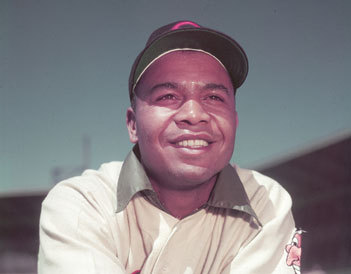 you do him justice? For another, since he is an iconic figure, there is a lot of info out there on him already. What are you going to write that is fresh?
you do him justice? For another, since he is an iconic figure, there is a lot of info out there on him already. What are you going to write that is fresh?
Myself: You know, black American pioneers are rightly celebrated for their bravery, talent and perseverance, yet Doby manages to remain underrated. Sure, Jackie Robinson of the Brooklyn Dodgers was the first black major leaguer when he debuted in 1947. But Doby was second, and he was only four months behind Robinson. Don’t forget: they were in different leagues, so in almost every American League town, Doby was the first, there. Think the fans in those towns knew it?
After passing four or five houses, the road turns sharply to the right and winds down a half mile to the creek and the old covered bridge. I try to straighten up and lean back on the descent, but my legs are still a bit tight. I try to lengthen my stride, to stretch out more.
Here is where those angry, mutant wasps rose from the ground behind the curb that one time a few years ago, and stung me twice before I caught onto their evil scheme. There is where the dark, overweight, bandana-clad German Shepherd barks and bears her white fangs at me. She’s anchored in the yard by a chain tethered to a weak-looking metal corkscrew that has been twisted into the ground. By the road, as usual. She hates me, but it’s my fault. Last year, I was tired of her woofing at me so when she started up again, I stopped and screamed an abrupt, “HUSH!” Stunned for a moment, she resumed her menacing barking with renewed vigor. I think this is how our relationship will remain, until one of us is gone.
I enjoy trotting through the bridge. I look up, marveling at the severely jagged, fierce-looking hornet nests on the underside of the roof. I shake my head as my eyes are diverted to some trash on the ground. I have little patience for the selfish, the ones who have no respect. My scowl yields to a slight grin as I channel Michael Keaton in Night Shift: “Watch out, stand back.” (Speaking into a pretend tape recorder) “This is Greg. Idea to eliminate unsightly garbage. Fast food bags with photos of street debris on them. Weeds, pebbles, roadkill. If you throw your trash out the car window, you don’t see it! You litter: you see nothing!” Ha.
Myself: Doby faced taunts and threats on and off the field. So did the man that signed him, Indians owner Bill Veeck. When Doby joined the Tribe in 1947, Veeck made sure he came directly from the Negro Leagues to the big league club. A minor league stint would normally have been the appropriate way to acclimate Doby to the majors, but Veeck wanted to expose him to one league’s worth of racial taunts and insults – not two. Veeck also took measures to pave the way for Doby among his teammates. A few were openly hostile to him, and several were indifferent to his struggles with abuse and the segregation on road trips. Veeck told the team the 23 year old was going to be a star, bigger than any of them. And if anyone wanted to leave, they could. Nobody did. Notable for their openness and friendship to Doby were C Jim Hegan, P Bob Lemon, 2B Joe Gordon, and P Steve Gromek.
Me: Doby really struggled in the 29 games he played for the Indians in 1947. But starting with spring training in 1948, he came alive. He was moved from second base to center field, and was a Most Valuable Player candidate on the World Series champion Indians. Former Indians great Tris Speaker was one of 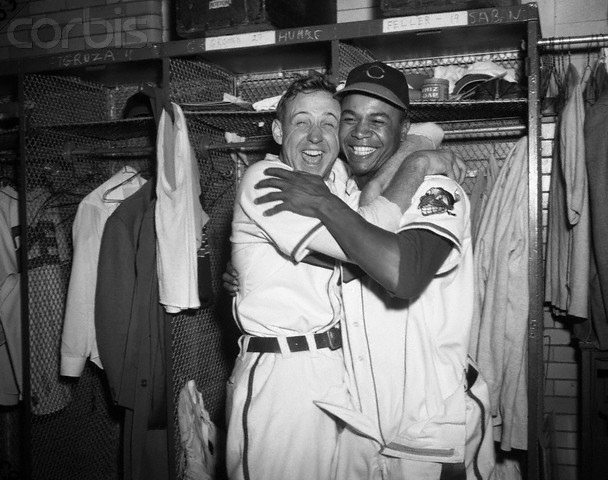 those who worked with Doby on his outfield play.
those who worked with Doby on his outfield play.
Remember that famous photo of Doby and the white ballplayer smiling and hugging during the Series in 1948? The teammate was Gromek, who’d pitched a complete game victory in Game 4. It was a significant moment in baseball- and U.S.- history, and a moment that Doby called his most cherished memory.
Emerging from the bridge, the road narrows as it curls to the right, along the creek for another half mile. On the right is the flat creek bed. It is mostly dry this time of year; in the spring when it floods, the park rangers close the secluded road and it becomes an inviting dog walk for those living nearby. On the left is the wooded incline that hides the old seminary that was recently converted into a senior housing facility. The speed limit through here is 35 mph, but you know everyone zips through at upwards of a dangerous 45-50. You think about getting a t-shirt made up that looks like a big white road sign announcing: 35 MPH. Oh, that would really piss some people off, wouldn’t it? Besides, truth be told? I drive at least 40 here myself. But runners get a wide berth.
There is one spot here in the low lands where I try not to breathe as I pass. This is an especially humid area that apparently is where the local deer go to die. Well, at least it smells of deer. Or of bodies of a similar size. I keep moving ahead.
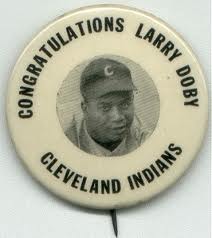 Me: So, hotshot, which game are you going to highlight in a piece on Larry Doby?
Me: So, hotshot, which game are you going to highlight in a piece on Larry Doby?
Myself: There are several I could choose from. In his career, Doby became the first black man to hit a home run in an All Star game (he played in seven) and in a World Series (he played in two). I could look at those games.
He hit for the cycle on 6/4/52. He hit three home runs in his first three times up to the plate on 8/2/50. And that’s not even mentioning his stellar defense. But I think I’ll look at 4/23/48. This was the first really good game of Doby’s major league career. As we noted, he’d struggled up to that point and had a lot to prove. The pressure must have been tremendous.
I’ve been running for a mile-and-a-half at this point, much of it downhill. I am not yet back to being in the shape I like to try to stay in. It’s been much too hot to run enough lately. So while I am nice and loose now, I know I’ll need to rest in a few short minutes. Today, the shins are beginning to fail me and I am having some trouble lifting my toes as I stride.
I take a left on the park road, into the hill, where the park grounds begin in earnest. I slow to a walk at the small, shaded roadside parking area next to the abandoned baseball backstop. A couple empty cars await their drivers and their dogs, who have disappeared into a wooded trail. I catch my breath, and check the volume on my nano. (Note: I do not need to keep running when I need to wait to cross streets, and I never check my pulse. I also do not carry a water bottle with me when running on a treadmill. Such activity is either for rookies, or the pretentious. Or both.)
Me: Early in the World Championship season of 1948, the Indians were at Detroit to face the Tigers. Both teams were undefeated. The pitching matchup was Bob Lemon for the Tribe vs. Fred Hutchinson for the Tigers. Doby singled in the first inning, but was stranded. When he came to the plate in the top of the 3rd, he clobbered a two-out home run to put the Indians up, 1-0.
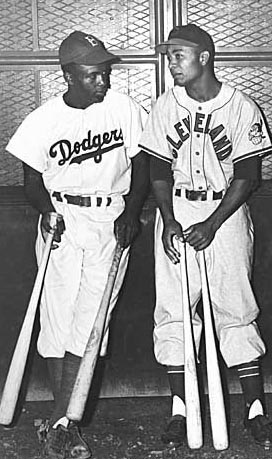 He also singled to left in the 8th inning, and scored on a single to right by SS Lou Boudreau.
He also singled to left in the 8th inning, and scored on a single to right by SS Lou Boudreau.
Doby finished 3 for 5 with 2 runs scored and an RBI out of the two-hole in the batting order. His friend Bob Lemon earned the complete-game victory, an 8-2 win. The game was in the middle of a six-game winning streak the Tribe enjoyed, to start the season. Both the Indians, and Larry Doby, were beginning an historical era.
My shin muscles revive as I pace the parking area, so I am ready for the six-tenths mile, uphill jog. My head down, I lean into this section of the trip. It is a grind. I try not to breathe and wheeze too hard, especially if there are picnickers in the shelters I pass on the way up. Any pretense of appearing cool is abandoned here. Eventually, the road levels out and dead ends into another park road. I can decide: if I take a left, I can enter a circular trail that dips down to another creek. This is shady, and if dry, it’s a solid choice. If I take a right, I can take a driveway to the top of a sledding hill that gives me a full two miles of travel before I make the turn to go home.
There is a restroom here at the top of the hill, as well. And a drinking fountain. It is also where a park ranger once stopped his SUV and got out and asked me if I’d seen a naked man who had been reported walking around the area (I had not). People are strange…
Me: Larry Doby was voted the best center fielder in baseball in 1950 by The Sporting News. His competition included Joe DiMaggio and Duke Snider. He was a core member of the 1948 World Champion Indians, as well as the 1954 A.L. pennant winning team.
Myself: Yes, a team that won a record 111 games. Doby tied a record in1953 by only committing two errors in center field. He would eventually be traded by the Indians, and returned for one season later in his career. Veeck had been right- Doby became a star, although there were some detractors, who thought he was selfish and sullen.
Me: Doby endured years of derision. He’d later say he preferred to remember the Gordons and the Veecks and the Hegans, but he’d allow that being looked at as a black man, rather than as a human being, took its toll.
Myself: Why wouldn’t it?
Me: His path was tougher than Jackie's, with the lack of a minor league tune up; also, Jackie played with a fire in the belly while Larry was more laid back. They both blazed a trail of racial integration in the postwar U.S. Robinson rightfully gets the credit, while Doby still really doesn’t.
Myself: Interesting side note: Veeck signed Doby as the second black ballplayer in major league baseball. Doby was also the second black manager in the big leagues, with the White Sox. The man who signed him was Veeck, again.
I typically walk some of the return trip home. Sometimes I even take a shortcut. And after a shower, it’s time to relax.
I need to unwind. How is the Tribe doing? Uhhhhhhhhhhhhhh. Oh.
Thank you for reading.
Sources included Tribe Memories, the First Century, Schneider; The Cleveland Indians Encyclopedia, Schneider, baseball-reference.com; Wikipedia.
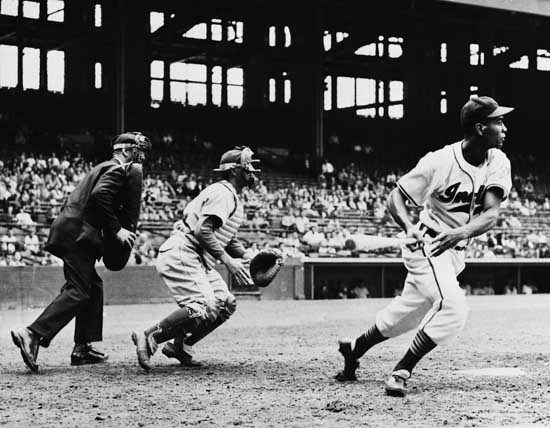
- NBA Announces 2013-2014 Schedule
- Browns Ink Sharknado
- Sharknado A No-Show For Rookie Camp
- Trent Richardson Out Until Training Camp
- Browns Sign Brandon Jackson
- Carrasco Suspended Eight Games
- Browns Add to Wide Receiver Depth with David Nelson
- Browns Need to Learn from Past Draft Mistakes
- Browns Release Chris Gocong and Usama Young
- Browns Missing on Grimes Disappointing, But Not The End
The TCF Forums
- Chris Grant's first 3 drafts
Kingpin74 (Tuesday, January 21 2014 10:13 AM) - The 2014 Offseason Thread
googleeph2 (Tuesday, January 21 2014 9:36 AM) - 2015 Recruiting
furls (Tuesday, January 21 2014 6:57 AM) - Mike Brown
YahooFanChicago (Monday, January 20 2014 11:15 PM) - Movies coming out
HoodooMan (Monday, January 20 2014 9:34 PM) - 2014 Hoops Hockey Hijinx
jpd1224 (Monday, January 20 2014 4:44 PM) - 2014 Recruiting
jclvd_23 (Monday, January 20 2014 2:26 PM) - Wish List - #4 Pick
Hikohadon (Monday, January 20 2014 1:26 PM) - Official- Browns Coach Search/Rumors
OldDawg (Sunday, January 19 2014 6:48 PM) - #1 overall pick Anthony Bennett
TouchEmAllTime (Sunday, January 19 2014 1:28 PM)


